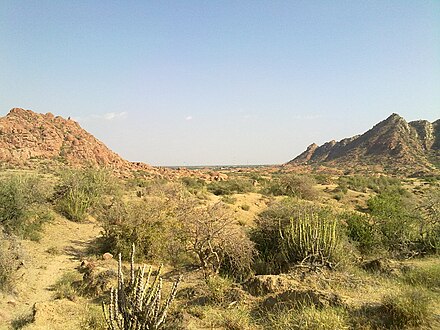Nagarparkar Tehsil
Nagarparkar
نگرپاركر | |
|---|---|
Tehsil | |
 View of Nagarparkar from the Karoonjhar Mountains | |
 | |
| Coordinates: 24°21′21″N 70°45′16″E / 24.35583°N 70.75444°E / 24.35583; 70.75444 | |
| Country | |
| Province | Sindh |
| District | Tharparkar |
| Area | |
| • Total | 3,862 km2 (1,491 sq mi) |
| Population (2017) | |
| • Total | 259,880 |
| • Density | 67/km2 (170/sq mi) |
| Time zone | UTC+5 (PST) |
Nagarparkar (Urdu: نگرپاركر, Sindhi: ننگرپارڪر), is a tehsil in at the base of the Karoonjhar Mountains in Tharparkar District in Sindh province of Pakistan. The historic Churrio Jabal Durga Mata Temple is situated here. The taluka is located at a distance of 129 km from Mithi, in Sindh, Pakistan.
Description
The name comes from the original word Nangar Parkar. It is at the foot of the Karoonjhar Hills. It is situated at a distance of about 16 km from south and about 23 from east from the Indian border. At one time the area was under the sea, which had to be crossed; the name "Parkar" means "to cross over". Nagarparkar has Chachro taluk on its north, and on its west is Islamkot taluk, while on east of it lies Barmer district of the Indian state of Rajasthan and on its south is Rann Kachchh and the Indian state of Gujarat. The surrounding area is a rocky belt called Parkar, and the remaining part is a sandy area.
The Karoonjhar hills cover 16 miles in the south of Nagarparkar taluk. The granite stone of this mountain is used for making tiles. There is a saying that the Karoonjhar hills provide 1-1/4 kilos of gold every day in the form of red granite stone, china clay, and honey. In summer, different sounds are audible from the rock due to sulfur deposits.
Demographics
In 1998, the population of the taluka was 153,106, out of which 90,513 were Hindus and 62,213 Muslims.
As of 2017 census Nagarparkar Taluk has a population of 259,880 and had a percent annual growth rate of 2.82% over the period of 1998-2017. 11,801 (4.54%) live in urban areas. The sex ratio was 901 females per 1000 males and the literacy rate for people 10 years and above was 24.17%, the lowest in all taluks of Tharparkar district. Hindus were 165,204 while Muslims were 94,065.[1]
Nagarparkar is located at a unique position at the intersection of three major languages: Sindhi, Marwari and Gujarati. Although 97.78% of the population recorded their mother tongue as Sindhi and 1.62% as 'Other',[1] most people speak a blend of all three languages. Some of these varieties are Parkari Koli, Wadiyara Koli, and Kachi Koli.
Culture
Nagarparkar Jain temples
The region once had a significant Jain population. Shri Gaudi Parshvanth Stavan in 1650 described the Parkar as the most glorious of all regions of India.[2]
The remains of a number of Jain temples are popular tourist attractions and heritage sites in the region.[3]
Churrio Jabal Durga Mata Temple
Churrio Jabal Durga Mata Temple, on Churrio Jabal hill in Choryo village, is one of the two Hindu temples in this place. On Shivratri 200,000 pilgrims visit the temples. Hindus cremate the dead and ashes are preserved till Shivratri for immersion in the into holy water. Richer Pakistani Hindus go to India to immerse the ashes in Ganges and the rest visit Nagarparkar to immerse the ashes. This area has been leased by the government for the mining by dynamite blasting of the hills on which the temples are located. This is posing a threat to the temples. Angry pilgrims held a protest against mining.[4]
There is one rest house beneath the Karoonjhar Mountain, but it partially collapsed during the 2001 Gujarat earthquake. This region is now a significant place of worship for the minority Hindu community due to the temple being located there. Sardharo, Anchlesar, and Jain temples are situated there.
Gallery
-
Jain Temple of Bhodesar
-
An ancient Jain temple at Nagarparkar
-
Virawah Jain Temple
-
Gori Temple
-
Bhudesar Mosque
-
Jain Temple ruins
See also
References
- ^ a b c "District-wise Tables: Tharparkar". pbs.gov.pk. Pakistan Bureau of Statistics. 2017.
- ^ Shri Gaudi Parshvanth Stavan, Bhanvarlal Nahta, Shri Gaudi Parchvanath Tirth, Muni Jinavijaya Abhinandan Granth, Ed. Dalsukh Malvania, Jinavijayaji Samman Samiti, Jaipur, 1971, p. 263-275
- ^ "Vanishing temples of Thar and Nagar Parkar, Ameer Hamza, Dawn, October 21, 2006".
- ^ Contractor blasting through Tharparkar temple in search of granite , The Express Tribune, 10 Mar 2011.







